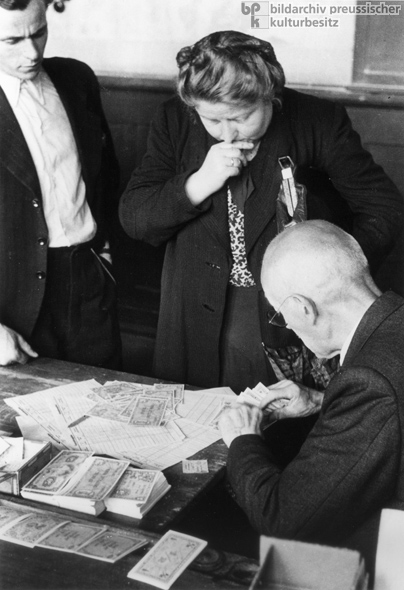













EINLEITUNG | DOKUMENTE | BILDER | LANDKARTEN | HERAUSGEBER
|
Um die Durchführung des Marshallplans zu erleichtern, den Schwarzmarkt auszurotten und ein günstigeres Verhältnis zwischen verfügbaren Waren und im Umlauf befindlicher Währung zu schaffen, war eine Währungsreform dringend nötig. Mit der am 20. Juni 1948 durchgeführten Währungsreform wurde in den westlichen Besatzungszonen die Deutsche Mark (DM) eingeführt und jeder Einwohner durfte eine Summe von 40,- DM sofort eintauschen. (Eine zweite Rate von 20 DM wurde später ausgezahlt.) Auf dem Bild ist die Auszahlung von DM 40,- „Kopfgeld“ pro Person in einer Ausgabestelle in der Münchner Karmeliter-Schule zu sehen. Gleichzeitig zur Einführung der Reform kündigte der Wirtschaftsdirektor der Bizone, Ludwig Erhard, Maßnahmen zur Aufhebung der Preiskontrollen für zahlreiche Waren an. Die Regale in den Geschäften wurden gefüllt (oft mit bisher gehordeten Waren) und der Schwarzmarkt verschwand praktisch über Nacht. Zwei Tage nach der Einführung der Reform im Westen verkündeten die Sowjets eine eigene Währungsreform, die für die SBZ und ganz Berlin gelten sollte, um die Stadt als Wirtschaftseinheit innerhalb ihrer Zone zu bewahren. Die Westalliierten wandten sich jedoch gegen die Einbeziehung Berlins und führten stattdessen die DM in ihren Sektoren ein. Am 24. Juni 1948 reagierte die Sowjetunion mit einer Blockade der Westsektoren der Stadt. Foto: Hans Hubmann
© Bildarchiv Preußischer Kulturbesitz |
 Druckfassung
Druckfassung zurück zur Bilder-Liste
zurück zur Bilder-Liste vorheriges Bild
vorheriges Bild
